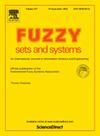基于三角模糊随机变量的加性季节分解时间序列模型
IF 2.7
1区 数学
Q2 COMPUTER SCIENCE, THEORY & METHODS
引用次数: 0
摘要
本文针对观测数据为三角模糊数而非精确值的情况,建立了一种常见的加性季节分解时间序列模型。为此,首先定义了三角模糊随机变量的自相关概念和相应的估计量。然后讨论最重要的性质,如一致性。对未知模糊趋势、模糊季节性和模糊余项进行了三个阶段的估计。在第一阶段,用局部多项式回归模型估计未知模糊趋势项。在第二阶段,推广了一种模糊季节性项的估计方法。一般的调和回归模型确定了模糊季节性项的中心,并使用常用的非参数时间序列模型估计了左右离散度。然后利用模糊数的广义差分运算对未知余项求值。扩展的自相关函数表示保证了模糊余项是近似有噪声的。在处理三角模糊数时,使用六个完善的评估拟合优度的标准来衡量所提出的时间序列模型与其他时间序列模型相比的有效性。通过仿真研究和两个实际模糊数据应用的对比分析,证明了所提出的时间序列模型的实用性和优越性。本文章由计算机程序翻译,如有差异,请以英文原文为准。
An additive seasonal decomposition time series model based on triangular fuzzy random variables
In this paper, a common additive seasonally decomposed time series model is developed for the case where the observed data are triangular fuzzy numbers instead of exact values. For this purpose, the concept of autocorrelation and the corresponding estimator for triangular fuzzy random variables are first defined. The most important properties, such as consistency, are then discussed. The unknown fuzzy trend, fuzzy seasonality and fuzzy remainder terms are estimated in three stages. In stage 1, the unknown fuzzy trend term is estimated by a local polynomial regression model. In stage 2, a methodology for estimating the fuzzy seasonality term is extended. A general harmonic regression model determines the center of the fuzzy seasonality term, and we estimate the left and right dispersion using a commonly used nonparametric time series model. We then evaluate the unknown remainder term using a generalized difference operation of fuzzy numbers. An extended autocorrelation function representation ensures that the fuzzy remainder term is approximately noisy. Six well-established criteria for assessing goodness-of-fit are used to measure the effectiveness of the proposed time series model in comparison to other time series models when dealing with triangular fuzzy numbers. The practical applicability and superiority of the proposed time series model are demonstrated by a comparative analysis using a simulation study and two applications with real-life fuzzy data.
求助全文
通过发布文献求助,成功后即可免费获取论文全文。
去求助
来源期刊

Fuzzy Sets and Systems
数学-计算机:理论方法
CiteScore
6.50
自引率
17.90%
发文量
321
审稿时长
6.1 months
期刊介绍:
Since its launching in 1978, the journal Fuzzy Sets and Systems has been devoted to the international advancement of the theory and application of fuzzy sets and systems. The theory of fuzzy sets now encompasses a well organized corpus of basic notions including (and not restricted to) aggregation operations, a generalized theory of relations, specific measures of information content, a calculus of fuzzy numbers. Fuzzy sets are also the cornerstone of a non-additive uncertainty theory, namely possibility theory, and of a versatile tool for both linguistic and numerical modeling: fuzzy rule-based systems. Numerous works now combine fuzzy concepts with other scientific disciplines as well as modern technologies.
In mathematics fuzzy sets have triggered new research topics in connection with category theory, topology, algebra, analysis. Fuzzy sets are also part of a recent trend in the study of generalized measures and integrals, and are combined with statistical methods. Furthermore, fuzzy sets have strong logical underpinnings in the tradition of many-valued logics.
 求助内容:
求助内容: 应助结果提醒方式:
应助结果提醒方式:


